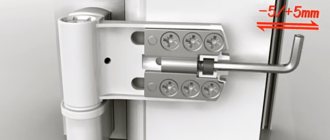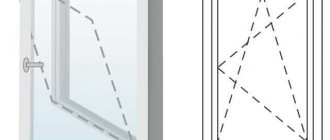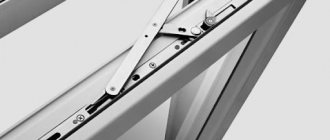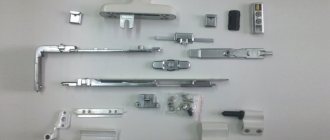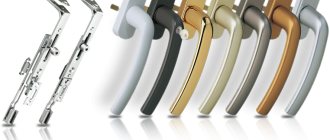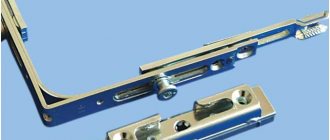Every year there are fewer and fewer wooden frames. The old ones become unusable and dry out and no longer protect against nanodrafts. Homeowners prefer sealed and inexpensive double-glazed windows. But tightness also has a negative side - gas exchange in the room remains at a low level. Microventilation in plastic windows offers a solution to a serious problem. This technology and its varieties, how the device works, how to choose it and how to install it yourself will be discussed in the article.
Why can the microclimate worsen?
A comfortable microclimate consists of several conditions, one of which is the renewal of indoor air. People breathe, emit carbon dioxide and water vapor, which is why in a confined space, for example in a room, the concentration of these gases gradually increases.
Cooking, washing and drying clothes, and cleaning also involve water, which means they also increase the moisture content in the air. When gas burns in a gas stove, both carbon dioxide and steam are released. Excessive humidity and high concentrations of carbon dioxide are perceived as stuffiness - people feel unwell, get tired quickly, and diseases can worsen in chronic patients.
To maintain a person’s well-being, it is very important to remove air saturated with moisture and carbon dioxide and supply fresh air instead. Sanitary standards require that the flow of fresh air in residential premises be at least 30 m³/hour per person. For kitchens, especially if they are equipped with gas stoves, the air exchange rate should be greater - up to 180 m³/hour.
Typical mass-built houses are equipped with exhaust ventilation with natural air movement. In this case, air is removed from the kitchen, bathroom and toilet, that is, from the rooms with the dirtiest air. It is assumed that the main air flow occurs through windows in residential premises - through leaks, open sashes and vents. Then the air from the rooms enters the corridor and from there into the bathroom, from which it goes into the exhaust ventilation ducts.
According to the laws of physics, air pressure decreases with altitude. This is why an upward thrust appears in a vertical pipe - the air pressure at the lower end of the pipe is higher than at the upper end. The air in the natural ventilation channels moves under the influence of this draft - no fans or other mechanical devices are needed for its operation.
If the apartment has wooden windows with their leaks and cracks, such ventilation functions more or less properly - the air that goes into the hood through the cracks in the windows is replaced by air from the street. When the windows are replaced with plastic ones, the flow of air from outside stops and ventilation stops working almost completely when the windows are closed. The tightness of plastic windows turns from an advantage into a problem - the rooms become stuffy, dampness accumulates in the air, causing the windows to fog up, external walls with insufficient thermal insulation begin to become damp, and mold appears...
Methods of ventilation of plastic windows
The flow of fresh air can occur in several ways:
- along a specially equipped channel, bypassing the windows;
- through the slightly open window sash
- through special channels in window frames.
Each of these options has its pros and cons, and they differ in price. There is no universal solution, so in different situations you should choose the optimal solution depending on the circumstances. Let's consider the listed options in more detail.
Installation features
It is not recommended to try to save money by installing a window structure yourself if you do not have experience in the window business. The involvement of professional specialists in the installation of plastic structures will allow you to avoid many problems during subsequent operation.
If installation work is carried out incorrectly, excess moisture and even rotting of the structure cannot be avoided. As a result, money paid for new plastic products will be lost and living conditions will deteriorate.
Ventilation via supply valve
A channel with a diameter of 150–200 mm is made in the outer wall next to the window, into which a dust and insect filter and a valve are installed that allows you to regulate the amount of air passing through it.
In addition to a simple valve with a filter, a recuperator or breather can be installed in the channel. The recuperator is a combined device that provides both air flow and exhaust removal. In cold weather, fresh air from the street is heated by the warm air escaping outside - this saves heat and prevents the air in the room from becoming overcooled.
Breezer is an even more complex and functional device. It not only heats the incoming air, but also thoroughly cleans it of dust, soot and plant spores. If an allergy sufferer lives in the room, the breather provides the necessary purification of the air from allergens.
Advantages of ventilation through a supply duct in an external wall:
- no intervention required in the window design;
- drilling the channel and installing the filter takes only a few hours;
- due to the large cross-section, a lot of air can pass through the channel;
- it is possible to organize full supply and exhaust ventilation in a specific room;
- a large selection of devices with various functionality, providing, for example, heating and cleaning of incoming air.
Minuses:
- special equipment is required to make a channel in the wall;
- depending on the material of the walls and other circumstances, the cost of installation work can be significant;
- a supply duct must be installed in every room of a house or apartment, which multiplies the cost of this technical solution.
Installing a supply ventilation duct in the wall is an effective but expensive solution. If you are not ready for such expenses, the air flow will have to be organized through the window, and this will require special fittings.
Where to buy plastic windows with a window in Moscow?
| "Moscow Windows" | 5/5 |
| "Windows of Comfort" | 3.5/5 |
| "Window Plastic" | 3/5 |
links to materials supplementing this article: Double-glazed windows sweat due to poor ventilation. How to eliminate fogging?
What is micro-ventilation of a plastic window?
How to adjust the pressure of a PVC window?
Step opening
As the name implies, in this case the slightly open sash is fixed in several positions. Technically, this is done either using a comb installed on the frame next to the window handle, or using a special folding mechanism.
Advantages of the comb:
- the most budget solution, a set of necessary parts can be bought at a construction hypermarket;
- You can install it yourself within 10 minutes (you will need a screwdriver);
- Suitable for both hinged and hinged sashes.
Minuses:
- installed in a visible place, spoils the appearance of the window;
- after dismantling, holes remain on the frame;
- Through a slightly open window, street dust enters the room and noise penetrates.
Hidden fittings do not spoil the appearance of the window, but to install them, you will need to invite a specialist. You can get more detailed information from VEKA consultants, and the company’s partners in your city will help you install it.
Solving the problem with a jammed sash
When talking about ventilation through windows, one cannot ignore the problems associated with this process. So, people often ask what to do if a plastic window jams in ventilation mode?
This is what a “fallen out” sash looks like
The reason for this situation is the following: if you try to switch the sash to the tilt mode from the rotary mode without closing it tightly enough, then the lower corner may simply not be secured. As a result, the sash hangs on one hinge and a lever that limits opening.
The problem is solved as follows:
- We lift the jammed sash and press it against the frame, returning it to the closed position.
- Separately press the lower corner of the sash, which is located opposite the lower hinge.
- We turn the handle, moving it to the “closed” position - i.e. lever down.
If the handle is jammed, i.e. it doesn't turn, you don't need to use force - you'll just break the lever. This situation most often occurs when the sash is skewed, so you should first try to carefully eliminate the skew. To do this, it is usually enough to slightly move the sash, applying force to the flap, and after opening, adjust the position of the hinges.
- After this, we repeat the attempt to open in ventilation mode - everything should work out!
To avoid such a development of events, it is worth installing such a part as an erroneous opening blocker. It prevents any attempt to move the sash into the turning position until it is completely closed and all hinges are engaged .
Erroneous opening blocker
Sometimes the reason why a plastic window does not open well for ventilation is wear and tear on the fittings. In this case, the optimal solution would be to clean it from contaminants (a mixture of dust and oil often forms a dense crust on the trunnions and mating elements) followed by lubrication.
After lubrication, you should turn the handle several times, checking how freely the window opens.
Well, if this doesn’t help, then probably only a specialist in fittings can help - so you should contact a specialist.
Micro-ventilation
The stepwise ventilation described above in the cold season gives too much influx of cold street air - the room becomes cold. The window has to be closed and opened periodically, which is inconvenient and troublesome. To prevent the room from getting too cold, the door should be open only a few millimeters.
This micro-ventilation mode is implemented by a special mechanism: the handle rotates upward at an angle of 45° between the “open” and “recline” positions - the sash opens a few millimeters. In this case, the window appears closed both from the outside and from the inside, and since the locking pins remain engaged with the strikers, the sash cannot be opened from the street side.
Advantages of slot ventilation:
- the air flow through the window is sufficient for ventilation, but does not cool the room;
- street noise is almost completely suppressed;
- The window remains locked and the room can be left unattended.
Minuses:
- installation of special fittings is required;
- air flow occurs almost along the entire perimeter of the sash, which is not always comfortable;
- the sash opens and closes manually.
Valves and their types
Ventilation valves are placed at the top of the window. This arrangement not only makes it less noticeable, but also provides a more comfortable microclimate. According to the laws of physics, the warmest air in a room accumulates at the top. Cold air from the street enters through the valve at the top of the window, where it mixes with warm air - its temperature is equalized, and it is perceived comfortably by people in the room.
Different types of valves are produced, but five can be distinguished structurally:
- rebated valves;
- slot type valves;
- overhead valves;
- built-in valves (valves installed above a double-glazed window)
- wall valves
Seam valves
These devices are mounted on the upper edge of the sash. At the valve installation site, the standard seals are replaced with thinner ones - a gap up to 40 cm long and several millimeters wide is formed. The air flow passes through these gaps in the space between the frame and the sash. If necessary, the valve can be completely closed from the room side.
Advantages of rebated valves:
- easy installation - you can install the valve yourself;
- the ability to return the window structure to its original state - if necessary, the valve can be dismantled and the standard seals can be installed back;
- availability and low cost of a set of parts.
Minuses:
- low ventilation performance due to the small cross-sectional area of the air channel; in fact, the valve does not fulfill its intended purpose;
- The rebated valve is installed only on opening sashes; installation on fixed sashes is not possible.
Slot valves
To install devices of this type, through rectangular channels are milled into the window frame. From the outside, these channels are covered with a canopy with an insect screen; on the inside, a valve itself is installed on top of the channels, allowing you to regulate and completely block the air flow.
Since air enters through channels specially milled in the frame and sash, slot valves can be installed not only on opening sashes, but also on fixed windows.
There are hygro-adjustable slot valves, in which the damper rotates to a larger or smaller angle depending on the humidity in the room. The higher the humidity, the more air the valve allows into the room.
Also in this class are acoustic valves that reduce street noise levels.
It is possible to retrofit the valves with serviceable pollen filters.
Pros of slot valves:
- suitable for installation on both opening and fixed windows;
- have a relatively high capacity, allowing you to effectively ventilate rooms without opening windows;
- have protection from insects;
- in acoustic design they protect from street noise;
- can be retrofitted with pollen filters;
- There are models with automatic control.
Minuses:
- complex installation requiring skills and special tools;
- the integrity of window structures is compromised;
- relatively high cost of the device itself and installation.
Overhead valves
Compared to the considered designs, overhead valves have the highest performance. As a rule, this class of valves is characterized by a wide range of inflow adjustment, protection from excessive ventilation (for example, in strong gusty winds) and improved acoustic protection. The most suitable application is large residential and public premises, high-rise buildings, buildings and structures located on the seashore.
In houses equipped with supply and exhaust ventilation, this problem does not exist - the flow of fresh air, regardless of the windows, is provided by supply ventilation, and the evacuation of exhaust air is provided by exhaust ventilation. If there is no supply ventilation in your house or apartment, you will have to do it. Today's article is about some ways to equip it.
The valve is mounted on the top of the window structure before installation in the opening.
The name of the valve in the picture is Airvent OF Aco
Advantages of overhead valves:
- high performance;
- the ability to adjust the air flow within a wide range;
- protection against excessive ventilation
- high levels of acoustic protection
- maintaining the integrity of the window structure
Minuses:
- reducing the light opening;
- high cost of the device.
Built-in valves (valves installed above the glass unit)
This type of valve is installed above a double-glazed window in a sash or fixed window. As a rule, this type of valve has high performance indicators and very mediocre thermophysical indicators. Therefore, it is most advisable to use these valves in rooms where a large influx is required and heat loss is not critical (for example, a boiler room in a private house) or in regions with a mild, warm climate.
The valve is mounted above the double-glazed window by reducing the height of the latter.
Advantages of built-in valves:
- high performance;
- possibility of adjusting the air flow within a wide range.
Minuses:
- reducing the light opening by reducing the glass unit;
- mediocre heat transfer resistance.
Wall valves
In cases where it is necessary to obtain a standard supply of fresh air and achieve high levels of protection from street noise, it is possible to use wall dampers. There are both the simplest manually controlled options and humidity-controlled options; it is possible to equip them with pollen filters.
The valve is installed in a hole in the wall (usually the diameter of the hole for the valve is 125 mm). For cases where, due to the presence of a ventilated facade, it is not possible to move the air intake to the outer surface of the wall, use the possibility of taking air from the area of the outer slope using additional elements.
Advantages of wall valves:
- high levels of acoustic protection from street noise;
- ensuring the required supply of fresh air;
- can be retrofitted with pollen filters;
- relatively low cost of the valve.
Minuses:
- installation complexity associated with the need for through drilling of the wall using a special tool;
Popular manufacturers of ventilation devices
One of the indicators of product quality is the reputation of the manufacturer. Companies that have proven themselves in the domestic market:
- Air-Box – Russia, produces mechanical “air inlets”;
- Ventec is a Russian company specializing in metal frame products, including ventilation systems;
- Tion – domestic;
- Vents is a Ukrainian company.
Ukrainian automatic ventilators have received European recognition. Belgium (Renson) produces Aerovent slot ventilators.
Valve Selection Guidelines
To choose the optimal one from several alternative options, proceed from the following considerations:
- determine the required valve capacity taking into account the air circulation rate of 30 m³/hour per person, also take into account the area of the room and the height of the ceilings - the larger the room, the more air is needed;
- select your preferred air flow control method - automatic, manual or mixed;
- Consider possible installation options - with the involvement of specialists or independently.
Please note that you will get the best result if you order the installation of supply valves along with the manufacture of windows. Experienced engineers will help you choose a device with the necessary functions and characteristics. Ask questions using the feedback form on the website or contact VEKA partners in your city.
How to choose a window ventilator
Unfortunately, not all models have proven to work flawlessly. Some are covered with ice in severe frost. Others do not work without forced ventilation. Still others lack power. In order for the device to live up to expectations, you need to choose the right model.
Main selection criteria:
- design;
- principle of operation;
- ventilator equipment (recommended additional filters, sound membranes, etc. for metropolitan residents and residents of disadvantaged ecological areas);
- throughput - depends on the volume of the room, the number of people living;
- Material of manufacture - metal gratings freeze.
When purchasing, pay attention to the ventilator manufacturer, whose models have received the greatest approval from customers.
